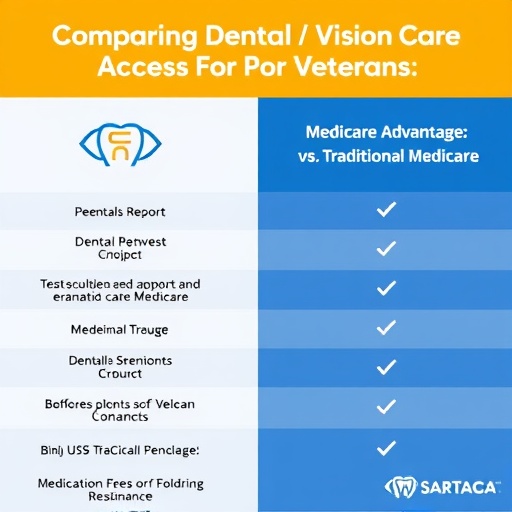A recent comprehensive study examining dental and vision care utilization among veterans enrolled in Medicare Advantage (MA) plans versus those in traditional Medicare (TM) has yielded intriguing results that challenge prevailing assumptions about supplemental benefits in managed care settings. Despite the extensive promotion and availability of supplementary dental and vision services within MA plans, usage rates among veterans appeared to mirror those observed in TM, a fee-for-service model. This unexpected parity calls into question the real-world effectiveness of supplemental benefit offerings in influencing health care utilization patterns within the veteran population.
From a financial perspective, the study reveals only marginal increases in spending by MA plans on dental and vision care relative to TM. This modest spending disparity persists even when emergency dental services are considered, suggesting a limited impact of supplemental coverage on acute care utilization. Intriguingly, when the potential confounds of private insurance coverage used by TM enrollees and their out-of-pocket expenditures are accounted for, the total dental services spending between both groups converges. This finding underscores the complex interplay of coverage, patient behavior, and service utilization that transcends the simplistic dichotomy of MA versus TM enrollment.
The veteran demographic introduces unique considerations in health services research due to their distinct health profiles and often enhanced access to care through Veterans Affairs (VA) benefits. The study’s insights may reflect these overlapping insurance mechanisms, potentially diluting the supplementary benefit effects observed in MA plans. Consequently, veterans’ use of dental and vision services might be influenced more by VA access or personal health priorities than by Medicare supplemental benefit structures alone.
Analysts posit that the comparable utilization rates may highlight systemic barriers that supplemental benefits in MA plans alone cannot overcome. Issues such as provider availability, geographic disparities, and veterans’ awareness or valuation of these benefits could attenuate their intended impact. This challenges MA plans and policymakers to consider multi-faceted strategies beyond benefit design to increase meaningful access and utilization of dental and vision care among veterans.
From a policy standpoint, the findings provoke important questions regarding the cost-effectiveness of including such supplemental benefits in MA plan offerings targeted at veterans. If increased access does not yield heightened usage, then the value proposition of these benefits to both enrollees and Medicare expenditures warrants reevaluation. The balancing act between enriching benefit packages and controlling health care spending remains a central concern as Medicare continues to evolve under demographic and fiscal pressures.
Clinicians and health economists alike may find these results salient when considering care coordination efforts for veteran populations within Medicare frameworks. Leveraging VA resources and integrating care pathways across programs might represent optimal approaches to enhancing health outcomes without duplicate or underutilized coverages. Such multidisciplinary, cross-system collaboration is increasingly recognized as vital to addressing complex healthcare needs in older adult populations.
Furthermore, the study highlights the critical role of data accounting for private insurance status and out-of-pocket payments when analyzing healthcare utilization and spending. The exclusion of these factors in prior analyses may have yielded inflated impressions of supplemental benefit impact, demonstrating the necessity of nuanced methodological approaches to health services research.
As the Society of General Internal Medicine Annual Meeting in 2025 showcases new findings, this investigation offers a sobering reminder of the limitations inherent in insurance design alone to modify patient behavior and healthcare use. It challenges researchers, policymakers, and healthcare providers to think beyond coverage expansions and towards integrated, patient-centered strategies that effectively promote the uptake of beneficial services.
Ultimately, while Medicare Advantage plans continue to market supplemental dental and vision benefits aggressively, empirical evidence among veteran enrollees signals a reassessment of strategic priorities. Realizing improved health outcomes will likely depend on addressing broader social, systemic, and patient-level factors that influence how healthcare services are accessed and utilized in this population. The study thus contributes importantly to the discourse on healthcare equity, utilization, and cost containment within the Medicare program’s evolving landscape.
Subject of Research: Utilization and spending on dental and vision services among veterans enrolled in Medicare Advantage vs. traditional Medicare.
Article Title: (doi:10.1001/jama.2025.7753)
News Publication Date: Not specified.
Web References: Not provided.
References: Not provided.
Image Credits: Not provided.
Keywords: Health insurance, Dental care, Vision, Health care costs, Emergency medicine
Tags: dental and vision services for veteransdental care utilization veteransfinancial analysis Medicare Advantagehealth care utilization patterns veteransmanaged care dental servicesMedicare Advantage plan effectivenessMedicare Advantage vs Traditional MedicareMedicare enrollment and usage ratespreventive care for veteranssupplemental benefits in Medicareveteran health care accessvision care access veterans





